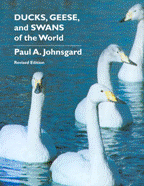Papers in the Biological Sciences

Ducks, Geese, and Swans of the World by Paul A. Johnsgard
Date of this Version
2010
Document Type
Book Chapter
Abstract
Pink-headed Duck ● Red-crested Pochard ● Southern Pochard ● Rosybill ● Canvasback ● Eurasian Pochard ● Redhead ● Ring-necked Duck ● Australasian White-eye ● Siberian White-eye (Baer Pochard) ● Ferruginous White-eye ● Madagascan White-eye ● Tufted Duck ● New Zealand Scaup ● Greater Scaup ● Lesser Scaup
This tribe of primarily fresh-water diving ducks contains 16 species that collectively may be called pochards. The tribe has a nearly worldwide distribution, but only a few of its species have ranges that extend beyond a single continent. In addition to 15 species that are very similar in body proportions and diving adaptations, the apparently extinct pink-headed duck has anatomical characteristics that approach those of the pochards and it clearly should be included in this tribe. All of the typical pochards are adept at diving and possess large feet, with long outer toes and strongly lobed hind toes. Their legs are placed quite far apart and are situated farther back on the body than in other ducks, making the birds relatively awkward on land but improving their diving efficiency. They also have a heavier body size to wing-surface ratio, forcing them to run for some distance over the water when taking flight, in contrast to the "springing" takeoff of dabbling ducks. Although sexual dimorphism occurs to some extent in all species, male plumage patterns are generally not especially complex, and the wing speculum patterns are either lacking or limited to gray or white stripes. The females of pochards are usually rather uniformly brownish, and lack the very distinct patterning of female dabbling ducks. Nesting is usually done on land near water or, more commonly, in beds of emergent vegetation. The downy young tend to be weakly or obscurely patterned with shades of yellow and dark brown.


Comments
In Ducks, Geese, and Swans of the World, by Paul A. Johnsgard. Electronic edition copyright © 2010 Paul A. Johnsgard.